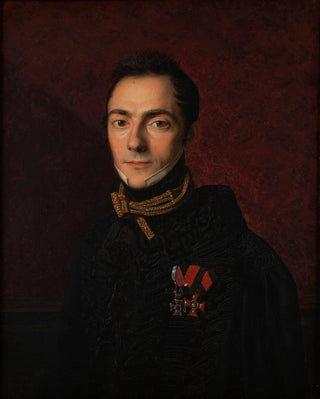Art print | Georg Graf Apponyi - Ferdinand Georg Waldmüller


View from behind

Frame (optional)
The art print Georg Graf Apponyi - Ferdinand Georg Waldmüller takes us into the fascinating world of the 19th century, a time when art intertwined with daily life with rare intensity. This piece, emblematic of romantic sensitivity, captures not only the portrait of a man but also the essence of an era marked by social and political upheavals. The finesse of details, the play of light, and the profound expression of the subject invite the viewer to introspective contemplation, revealing the underlying emotions behind each brushstroke. Through this painting, Waldmüller manages to establish an intimate connection between the model and the observer, making this work a centerpiece in the history of art.
Style and uniqueness of the work
Ferdinand Georg Waldmüller’s style is distinguished by his ability to combine realism and romanticism. In this piece, he deploys a delicate palette of colors, while emphasizing meticulous rendering of textures and expressions. The model’s gaze, tinged with melancholy, seems to tell a story—a narrative that each observer can interpret in their own way. The composition is carefully orchestrated, with each element in its place to create visual harmony. Waldmüller does not merely reproduce an image; he captures an atmosphere, a frozen moment in time, where the psychology of the model gradually reveals itself. This blend of intimacy and technical virtuosity makes this work a perfect example of 19th-century portrait art.
The artist and his influence
Ferdinand Georg Waldmüller, born in 1793 in Vienna, is one of the major representatives of Austrian realism. His work, marked by a keen sensitivity to the nuances of human life, influences many contemporary and future artists. Waldmüller successfully integrated elements of classical tradition while opening up to stylistic innovations that prefigure upcoming artistic movements. His approach to portraiture, where the subject becomes a vessel of emotions and reflections on the human condition, has left an indelible mark on art history. Through his creations, he established a dialogue with the viewer,

Matte finish

View from behind

Frame (optional)
The art print Georg Graf Apponyi - Ferdinand Georg Waldmüller takes us into the fascinating world of the 19th century, a time when art intertwined with daily life with rare intensity. This piece, emblematic of romantic sensitivity, captures not only the portrait of a man but also the essence of an era marked by social and political upheavals. The finesse of details, the play of light, and the profound expression of the subject invite the viewer to introspective contemplation, revealing the underlying emotions behind each brushstroke. Through this painting, Waldmüller manages to establish an intimate connection between the model and the observer, making this work a centerpiece in the history of art.
Style and uniqueness of the work
Ferdinand Georg Waldmüller’s style is distinguished by his ability to combine realism and romanticism. In this piece, he deploys a delicate palette of colors, while emphasizing meticulous rendering of textures and expressions. The model’s gaze, tinged with melancholy, seems to tell a story—a narrative that each observer can interpret in their own way. The composition is carefully orchestrated, with each element in its place to create visual harmony. Waldmüller does not merely reproduce an image; he captures an atmosphere, a frozen moment in time, where the psychology of the model gradually reveals itself. This blend of intimacy and technical virtuosity makes this work a perfect example of 19th-century portrait art.
The artist and his influence
Ferdinand Georg Waldmüller, born in 1793 in Vienna, is one of the major representatives of Austrian realism. His work, marked by a keen sensitivity to the nuances of human life, influences many contemporary and future artists. Waldmüller successfully integrated elements of classical tradition while opening up to stylistic innovations that prefigure upcoming artistic movements. His approach to portraiture, where the subject becomes a vessel of emotions and reflections on the human condition, has left an indelible mark on art history. Through his creations, he established a dialogue with the viewer,






